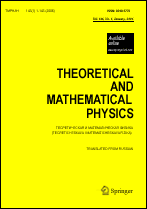|
This article is cited in 2 scientific papers (total in 2 papers)
Tensor gluons and proton structure
G. K. Savvidi
Institute of Nuclear and Particle Physics, Demokritos National Research Center, Athens, Greece
Abstract:
We recently considered a possibility that inside a proton and, more generally, inside hadrons there could be additional partons, tensor gluons, which carry a part of the proton momentum. Tensor gluons have zero electric charge, like gluons, but have a larger spin, and we therefore call them tensor gluons. A nonzero density of tensor gluons can be generated by the emission of tensor gluons by gluons. Tensor gluons can further split into pairs of tensor gluons through different channels. To describe all these processes, we must know the general splitting probabilities for tensor gluons. These probabilities should satisfy very general symmetry relations, which we can resolve by introducing a splitting index. This approach allows finding the general form of the splitting functions, deriving the corresponding DGLAP evolution equations, and calculating the one-loop Callan–Symanzik beta function for tensor gluons of a given spin. Our results provide a nontrivial consistency check of the theory and of the Callan–Symanzik beta function calculations because the theory has a unique coupling constant and its high-energy behavior should be universal for all particles of the spectrum. We argue that the contribution of all spins to the beta function vanishes, leading to a conformal invariant theory.
Keywords:
gauge theory, tensor gluon, renormalization group, Callan–Symanzik beta function, splitting function, DGLAP equation, asymptotic freedom.
Received: 20.06.2014
Citation:
G. K. Savvidi, “Tensor gluons and proton structure”, TMF, 182:1 (2015), 140–157; Theoret. and Math. Phys., 182:1 (2015), 114–129
Linking options:
https://www.mathnet.ru/eng/tmf8742https://doi.org/10.4213/tmf8742 https://www.mathnet.ru/eng/tmf/v182/i1/p140
|


| Statistics & downloads: |
| Abstract page: | 403 | | Full-text PDF : | 197 | | References: | 44 | | First page: | 16 |
|




 Contact us:
Contact us: Terms of Use
Terms of Use
 Registration to the website
Registration to the website Logotypes
Logotypes








 Citation in format
Citation in format 
